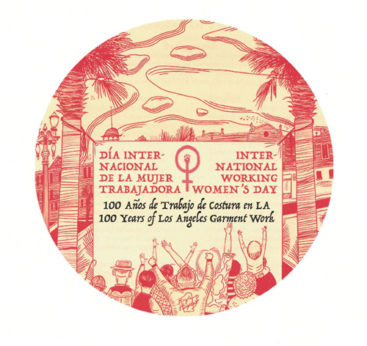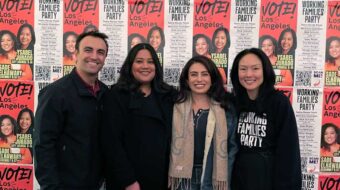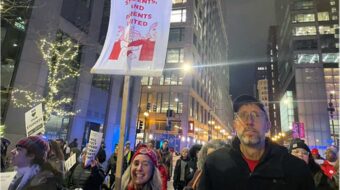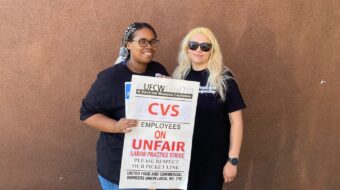
LOS ANGELES — To mark International Working Women’s Day/Día international de la mujer trabajadora, the UCLA Labor Center, pairing with the UCLA Center for Jewish Studies, sponsored an uplifting afternoon at the Labor Center’s building across from downtown’s MacArthur Park.
Dr. Caroline Luce, UCLA professor of labor history, had her students prepare graphic displays showing the history of women in the needle trades in Los Angeles. A hundred years ago these women were mostly Jewish and Italian, the same demographics of the garment industry in New York at the time. Over time, as new waves of immigrants arrived, the workers became mostly Latina and Asian.
A quilt board held a new banner to celebrate the centennial. Women (and a man or two) sewed down the appliquéd lettering and imagery, and added their own initials if they wished. Many of these women were current garment workers employed in the sweatshops of Los Angeles. This city is now the garment manufacturing capital of the United States, although these days most of the clothing worn in this country is made abroad for much lower wages.
Luce recounted the brief history of women working in the garment industry in L.A., and then invited labor organizer Cristina Vásquez to give the keynote address. Vásquez pointed out that the hall in which we were meeting belonged to the International Ladies Garment Workers Union (ILGWU), which later merged to become today’s UNITE HERE. It is now leased out to the UCLA Labor Center to serve workers in all industries.
An immigrant herself, from Mexico, Vásquez started early in garment worker organizing, starting as a trimmer in a shop. She moved to an office job, but when the workers struck for better pay and working conditions, she joined them on the picket line and was promptly fired. At that time, in the 1970s, immigrant labor was the poor stepchild of the labor movement. Labor leadership—which did not resemble the union membership—still believed that immigrants were taking jobs away from American citizens and lowering wages for all. Openly, at meetings of the L.A. County Federation of Labor in those days, disparaging comments could be heard about fellow workers from other countries who, like everyone else, were simply living paycheck to paycheck and trying to stay afloat.
After the immigrant women started winning some of their job actions, however, the tide started turning. When busloads of women garment workers appeared at boycott demonstrations against the anti-labor, anti-gay Coors beer company in the 1970s, and when the boycott won, immigrant labor won a new level of respect. Under the influence of County Fed leader Miguel Contreras, the movement came to see that organized labor meant defending all working people, and that together they would make a stronger labor movement. (Significant strains in the working class today need to be reminded of that lesson!)
In the early days of garment manufacturing, the whole garment was designed, created and marketed out of one company and one building. After NAFTA came in, much of the work could be subcontracted out to Mexico. A plethora of subsidiary companies popped up, nimbly able to avoid prosecution for labor abuses by shutting down operations, moving the sewing machines to another locale, changing the name and titular ownership of the firm and starting up again. The owners could not be found, the workers went unpaid.
 Sadly, the same issues that affected garment work a century ago, such as long hours, poor wages and no overtime, wage theft, locked doors, unhealthy and unsafe working conditions, all continue to exist today. There are even sweatshops in L.A. that literally employ slave labor, people from other countries held against their will, their passports taken, and forced to work for fear of deportation or harm to their families back home.
Sadly, the same issues that affected garment work a century ago, such as long hours, poor wages and no overtime, wage theft, locked doors, unhealthy and unsafe working conditions, all continue to exist today. There are even sweatshops in L.A. that literally employ slave labor, people from other countries held against their will, their passports taken, and forced to work for fear of deportation or harm to their families back home.
Under these conditions, Vásquez said, it’s impossible to simply organize shop by shop. We need to create a mass movement, pass laws and enforce them. This is what she wanted students at the UCLA Labor Center to take from this event: You can make change. Legislators and employers must in the end listen to workers, students, youth, and of course consumers.
Help us carry the banner of scarlet
In the concluding cultural portion of the program, the audience sang along to the familiar Mimi Fariña setting of the James Oppenheim poem “Bread and Roses,” which came out of the 1912 Lawrence textile strike.
In tribute to the early Yiddish-speaking Jewish workers in the trade, a new Spanish translation (by Dulce Ramírez Gómez) was read to accompany an English translation (by Rose Pastor Stokes) of the poem “In the Factory” by Morris Rosenfeld, one of the famous Jewish “sweatshop poets” of a century ago.
Ruth Judkowitz and this writer, two members of the Southern California Arbeter Ring (Workmen’s Circle)—which began in L.A. in 1908 and soon included a branch of ILGWU workers—sang the classic songs “Union Maid” and “Solidarity Forever.” They began with the 1891 song “Arbeter Froyen” (“You Working Women”) by another sweatshop poet, Dovid Edelshtat, who himself died young of tuberculosis from his hard working life. The trilingual printed program carried the verses of this song, including (perhaps for the first time?) a Spanish translation. All three versions are below:
You working women, suffering women,
Women who languish at home and in mills:
Oh, why don’t you help us in building the Temple
Of freedom and joy that will end the world’s ills?
Help us carry the banner of scarlet
Forward through storm and through the dark night.
Help us bring truth to all of the people,
To the unfortunate let us bring light.
Help us lift the world from oppression,
Raising up everything that we hold dear.
Struggle together like powerful lions,
For freedom, equality—principles clear.
More than once women have shown that they’re able,
Made tremble hangmen and throne.
They’ve shown the world that they can be entrusted
The holy banner in bitterest storm. (Trans. by Jerry Silverman)
En español:
Ustedes mujeres trabajadoras, mujeres que sufren,
Mujeres que languidecen en casa y en molinos:
Oh, por qué no nos ayudan en la construcción del Templo
De libertad y alegría que acabará con los males del mundo?
Ayúdanos a llevar la bandera escarlata
Adelante a través de la tormenta y por la noche oscura.
Ayúdanos a traer la verdad a toda la gente,
A los desgraciados traigamos luz.
Ayúdanos a levantar el mundo de la opresión,
Levantar todo lo que queremos.
Luchar juntos como leones poderosos,
Por libertad, igualdad—principios claros.
Más de una vez las mujeres han demostrado que son capaces,
Hacían temblar a los verdugos y trono.
Han mostrado al mundo que pueden ser confiadas
La bandera santa en la más amarga tormenta.
And in the original Yiddish:
Arbeter froyen, laydende froyen,
Froyen vos shmakhtn in hoyz un fabrik:
Vos shteyt ir fun vaytn, vos helft ir nit boyen
Dem templ fun frayhayt, fun mentshlekhn glik?
Helft undz trogn dem baner, dem roytn
Forverts durkh shturem, durkh finstere nekht.
Helft undz varhayt un likht tsu farshpreytn
Tsvishn umvisnde elnde knekht.
Helft undz di velt fun ir shmuts derheybn!
Ales opfern, vos undz iz lib.
Kemfn tsuzamen, vi mekhtike leybn
Far frayhayt, far glaykhhayt, far undzer printsip!
Nit eyn mol hobn shoyn nobele froyen
Gemakht tsitern henker un tron,
Zey hobn getsaygt, az men ken zey fartroyen,
In biterstn shturem di heylike fon.












Comments